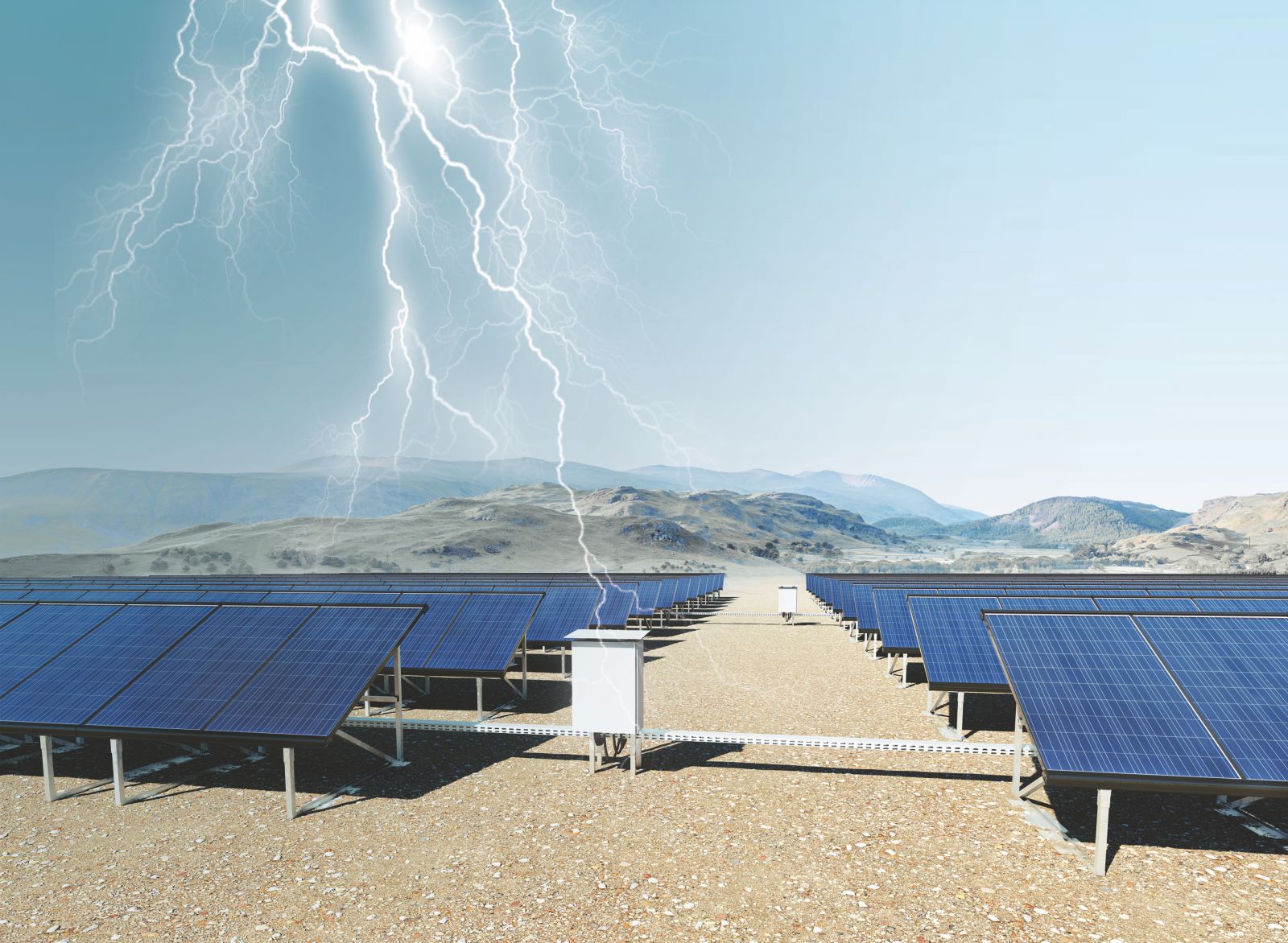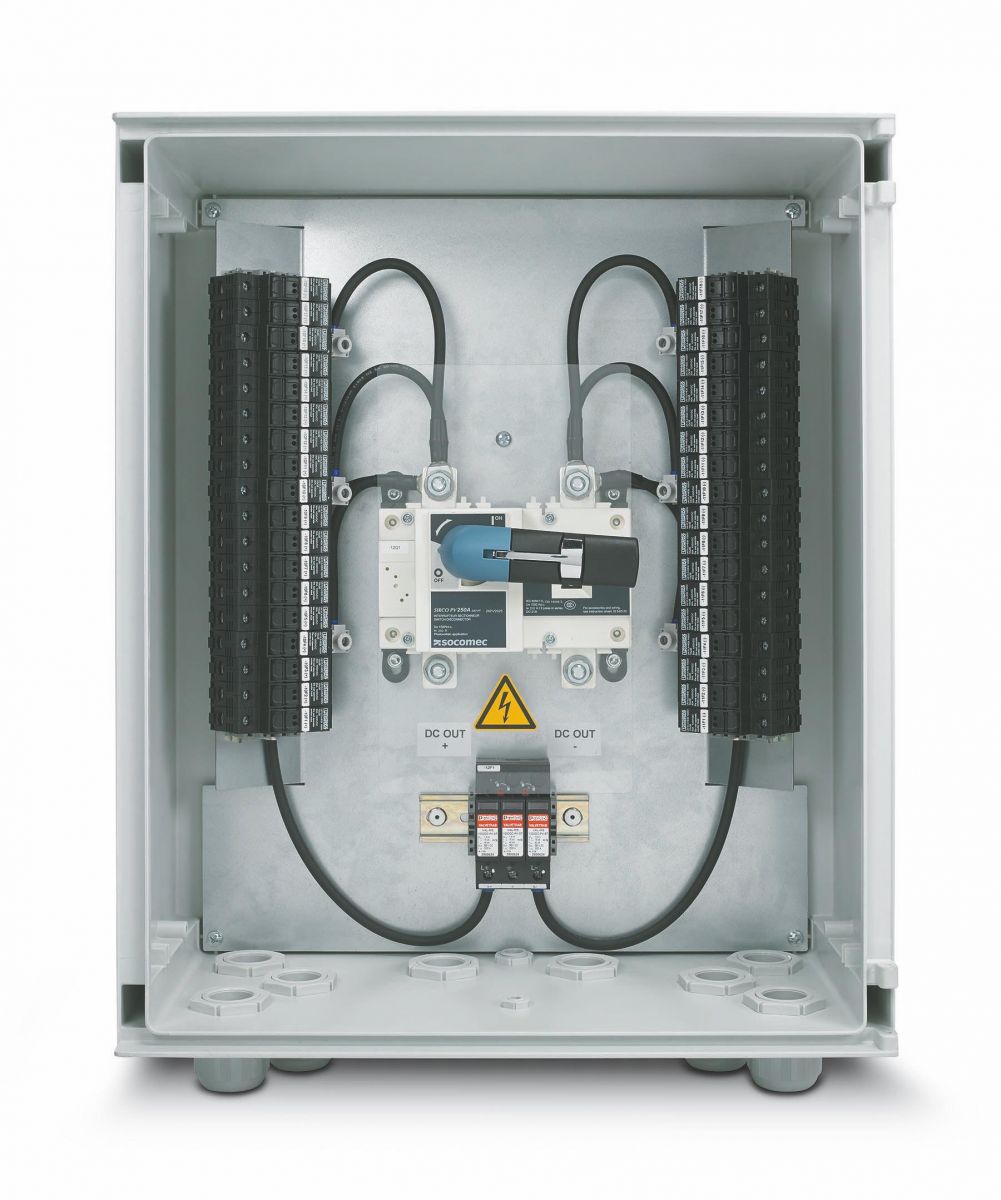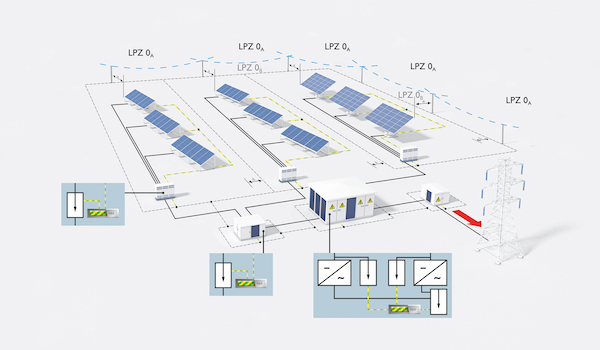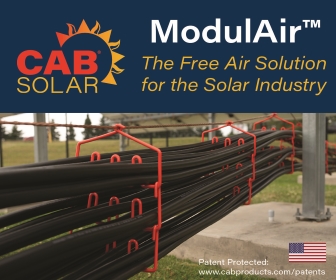Lightning vs. Solar - Risk detection, protection, and mitigation of utility-scale solar lightning surge events
Utility-scale solar project site locations are chosen for many factors, including solar resources, available land area, topography, electric grid capacity, and financial incentives. Weather usually does not play a significant role in this selection process. However, extreme weather events, such as lightning, can negatively impact both plant operations and economics. From an asset management perspective, it is important to understand both the risk factors associated with lightning-related surge events, and the available protection strategies that can help minimize their impacts on array performance.

Resources are available to aid in these efforts. Standards such as NFPA 780[1], analysis of PV field reliability[2], and other sources[3] can assist in identifying the major PV solar risk areas associated with lightning-related surge events. NFPA 780 also provides guidance as to selection and installation of surge protection devices (SPDs) for solar arrays. In the following sections, we will examine how these resources can help improve the reliability of utility-scale PV solar arrays.
Risk Detection
Highly dependent on location, some level of lightning-related risk almost always exists for utility-scale PV solar installations. Due to their typically ground-mounted location, the incidences of direct lightning strikes are, thankfully, rare. Lightning-related secondary surge events, however, are encountered with more frequency. Some of the major factors associated with lightning risk include:
- Location risk: Geographic location is a major factor in determining lightning risk. The lightning risk assessment contained in Appendix L of NFPA 780 is a good starting point to determine associated risks for solar installations. A few general trends can be observed. From the isokeraunic flash density map, it can be readily seen that, as PV solar installations have moved out of their early adoption locations in California, they have been installed in areas of increased lightning risk. From a risk management perspective, this has heightened the need to provide appropriate levels of surge protection against lightning-related surge events. A related risk factor is area of array ground coverage; with ever larger utility-scale arrays being installed in areas with higher flash density, the risk associated with lightning-related surge events has also increased.
- Equipment risk: Outside of direct lightning strike damage, the primary risk to utility-scale PV solar installations is damage to electronics and PV modules from secondary surge overvoltages. These overvoltages damage equipment by exceeding the dielectric strength of internal components. Unlike direct lightning damage, these surge impacts can be cumulative, reducing the ability to determine a direct causal effect between failures and events. Lightning events that cause overvoltages do not always strike within the boundaries of a solar array. Those that occur on utility pole lines, light standards, and other structures outside of the area of the actual array boundaries, increase the overvoltage risk to array equipment associated with these events.
- Operational risk: For PV solar arrays, operational risks are a function of several factors, which include type of equipment failures, frequency of occurrence, lost power production, and repair costs. PV field reliability analysis, which assesses the field dependability of PV solar installations, can help determine operation risks. From a lightning-related surge event perspective, these studies indicate that while direct lightning strikes are rare, area lightning events are more common. As such, the related failures associated with these events may not be reported directly under lightning strike information, but may instead be contained under array component failures.
While lightning-related surge events can seem to be a somewhat random occurrence, understanding their risks can help determine the levels of surge protection and mitigation steps necessary to reduce their impact on PV solar array performance.
 Protection
Protection
Available state of the art of surge protection technology is well developed. In lightning surge event applications, the objective is to protect all electrical components involved with power production, data, and monitoring within utility-scale solar arrays. This includes the AC and DC side of inverters, SCADA systems, weather stations, solar trackers, monitoring instruments, as well as ancillary electrical systems. For PV solar applications, detailed surge protection device and installation recommendations can be found in Chapter 12 of NFPA 780. As always, the grounding and bonding requirements of NEC 250 and solar installation requirements of NEC 690 must be followed to ensure safe and effective surge protection.
Two of the most critical factors for choosing direct-array connected SPDs are discharge circuit currents rating (In) and voltage protection rating (VPR). This can be thought of as the nominal maximum surge current (In) which the SPD will suppress surge voltages to below the overvoltage tolerance of the protected equipment. As an example, for the DC array side of a solar inverter, NFPA 780 recommends the use of an SPD with a discharge circuit current rating (In) of 20kA 8/20 µS per mode. The SPD VPR typically is recommended to be no greater than three times the maximum PV system voltage. For 1500V utility-scale PV solar installations, this will be 4500 V. Use of SPDs that meet these ratings will reduce failures and extend equipment life.
Mitigation
For utility-scale PV solar installations, array layout and design play an important role in lightning surge event mitigation. NFPA 780 again offers insight in this area. As an example, the recommended installation point for DC SPDs is at the combiner or recombiner box; this is considered the output of the array. If the distance from the combiner box to the inverter is greater than 100 feet (30 m), a second DC SPD should be installed at the inverter. This is a common option from most inverter manufacturers. If the inverter has multiple MPPT inputs, SPDs should be installed on each input. For installations that use string inverters with internal combiner boxes or external cable harnesses, installation of the DC SPD at the inverter will usually be adequate. However, for extremely long cable runs (in excess of 100 feet (30 m) from the array to the inverter) a DC SPD closer to the actual array output point should be installed.

As the utility-scale solar industry moves to higher power PV modules, including bifacial types, the DC SPD application guidelines do not change. This implies that with increased array power output, on a cost/watt basis, surge protection costs fall. This will help lower both the construction and operational costs of utility-scale solar arrays.
Daniel J. Sylawa is Senior Business Development Manager - Renewable Energy for Phoenix Contact USA, Inc., a global innovator in engineering.
Phoenix Contact USA | www.phoenixcontact.com
[1] NFPA 780, Standard for the installation of lightning protection systems, 2020 Edition (National Fire Protection Association, 2020)
[2] Dirk C. Jordan, Bill Marion, Chris Deline, Teresa Barnes, Mark Bolinger, PV field reliability status-Analysis of 100 000 solar systems (John Wiley & Sons, Ltd., 2020)
[3] The National Risk Index (Federal Emergence Management Agency), www.fema.gov
Author: Daniel J. Sylawa
Volume: 2021 March/April









.png?r=4557)


